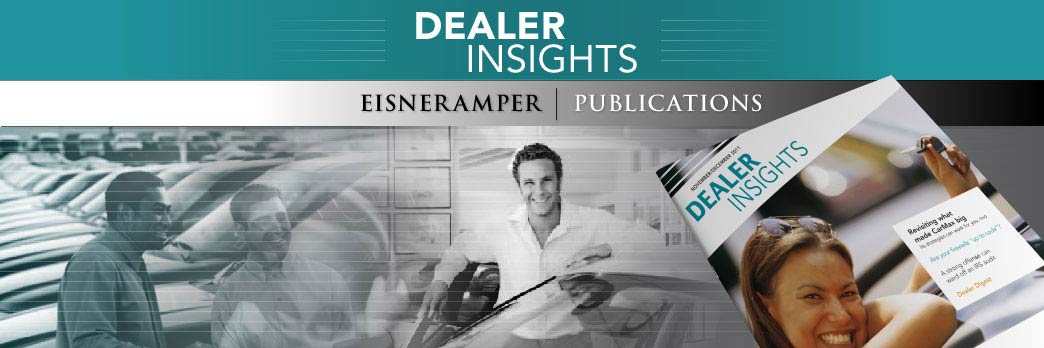
Recent Tax Law Adds Appeal to Asset Purchases
- Published
- Apr 26, 2016
- Share
Many dealers invest heavily in assets that can help them run their businesses more efficiently and better serve their customers. This typically includes computers and software (for example, a dealer management system), telecommunications gear and showroom furniture. Service department assets, such as diagnostic equipment, alignment racks and wheel balancers, also count as asset purchases.
Now there’s some great news for dealerships when it comes to the tax treatment of asset purchases. The increased Section 179 expensing limit for qualifying purchases, as well as the phaseout threshold, has been permanently extended and retroactively reinstated. Also, first-year bonus depreciation has been temporarily extended.
Benefits of expensing
These positive developments were part of the Protecting Americans from Tax Hikes Act of 2015 (the PATH Act), which was signed into law last December. Expensing fixed assets and writing them off during the year in which they’re placed in service offers big tax advantages compared to depreciating the assets over a number of years.
Before the PATH Act, Congress would typically wait until year end to decide whether to temporarily extend and retroactively reinstate these and other tax provisions. This made it hard for dealerships to plan their capital expenditure budgets for the year.
For example, on January 1, 2015, the Sec. 179 expensing limit fell from $500,000 to $25,000 and the phaseout threshold dropped from $2 million to $200,000. So, many dealerships spent almost all of last year wondering whether Congress would raise the limit and threshold. Because of this uncertainty, some dealerships may have hesitated to buy assets that could have improved their operations.
The annual uncertainty over Sec. 179 expensing is finally a thing of the past. Not only are the $500,000 expensing limit and $2 million phaseout threshold now permanent, but these amounts will be indexed annually for inflation in $10,000 increments. Expensing for qualifying annual asset purchases that exceed $2 million will be phased out dollar-for-dollar up to $2.5 million. Amounts above this can’t be expensed.
Remember that qualifying assets must be financed and placed in service no later than midnight on December 31, 2016, to be expensed this year. Your CPA can help you estimate how much money this tax break might save your dealership.
Another provision of the PATH Act allows dealerships to permanently use 15-year straight-line cost recovery for qualified leasehold and retail improvements. Had the Act not been passed, prior legislation would have required these items to be depreciated over 39 years.
Bonus depreciation also extended
In addition to making the increased Section 179 expensing limit and phaseout threshold permanent, the PATH Act extended first-year bonus depreciation through the end of 2019. Under this provision, your dealership can immediately expense 50% of the cost of new, qualifying property that’s purchased and placed in service in 2016 and 2017. The percentage will be reduced to 40% in 2018 and 30% in 2019 before phasing out completely in 2020.
For property placed in service after December 31, 2015, bonus depreciation is available for:
- New modified accelerated cost recovery system (MACRS) property with a recovery period not exceeding 20 years,
- Computer software,
- Water utility property, and
- Qualified improvement property.
This final item replaces “qualified leasehold improvement property,” and has a broader definition — including most improvements to an interior portion of your dealership if they’re made after the building was first placed in service. Also, original use of MACRS property must begin with your dealership.
Note that your dealership needn’t report net income to take bonus depreciation deductions, as you do to qualify for Sec. 179 expensing. Also, bonus depreciation isn’t limited to certain-size businesses — nor is there a limit to how much can be deducted. But bonus depreciation can’t be taken for used, tax-exempt use or tax-exempt financed property, or for property that will be used outside of the country.
Get advice
The assets you purchase should be based on sound business practices — that is, because you need the pieces of equipment to help you generate more net income. A plus to keep in mind: The tax benefit might allow you to purchase a higher quality piece of equipment than you could purchase if the tax savings weren’t available.
Consult with your tax advisor for more details on Sec. 179 expensing and bonus depreciation.
Automotive Dealer Insights - May/June 2016
Contact EisnerAmper
If you have any questions, we'd like to hear from you.
Receive the latest business insights, analysis, and perspectives from EisnerAmper professionals.









